A Comprehensive Analysis of Neptune's Discovery and Existence
VerifiedAdded on 2020/04/13
|12
|3408
|221
Essay
AI Summary
This essay provides a comprehensive analysis of the discovery of the planet Neptune, beginning with its identification and the key figures involved, including Johann Galle, Urbain Le Verrier, and John Couch Adams. It delves into the methods used to discover Neptune and the evidence supporting its existence, such as observations from telescopes and NASA's Voyager 2 mission. The essay examines the planet's physical characteristics, including its distance from the sun, atmospheric composition, and unique features like its rings and moons. It also explores conflicting accounts and alternative perspectives on the discovery process. Furthermore, the essay draws on various scientific sources to support the presented evidence, highlighting both confirming and contradicting viewpoints regarding Neptune's properties and discovery. The paper discusses the use of telescopes and the confirmation of Neptune's existence through NASA's findings, as well as pre-discovery observations by other scientists. The analysis covers the planet's characteristics, including the composition of its atmosphere and the presence of oceans.
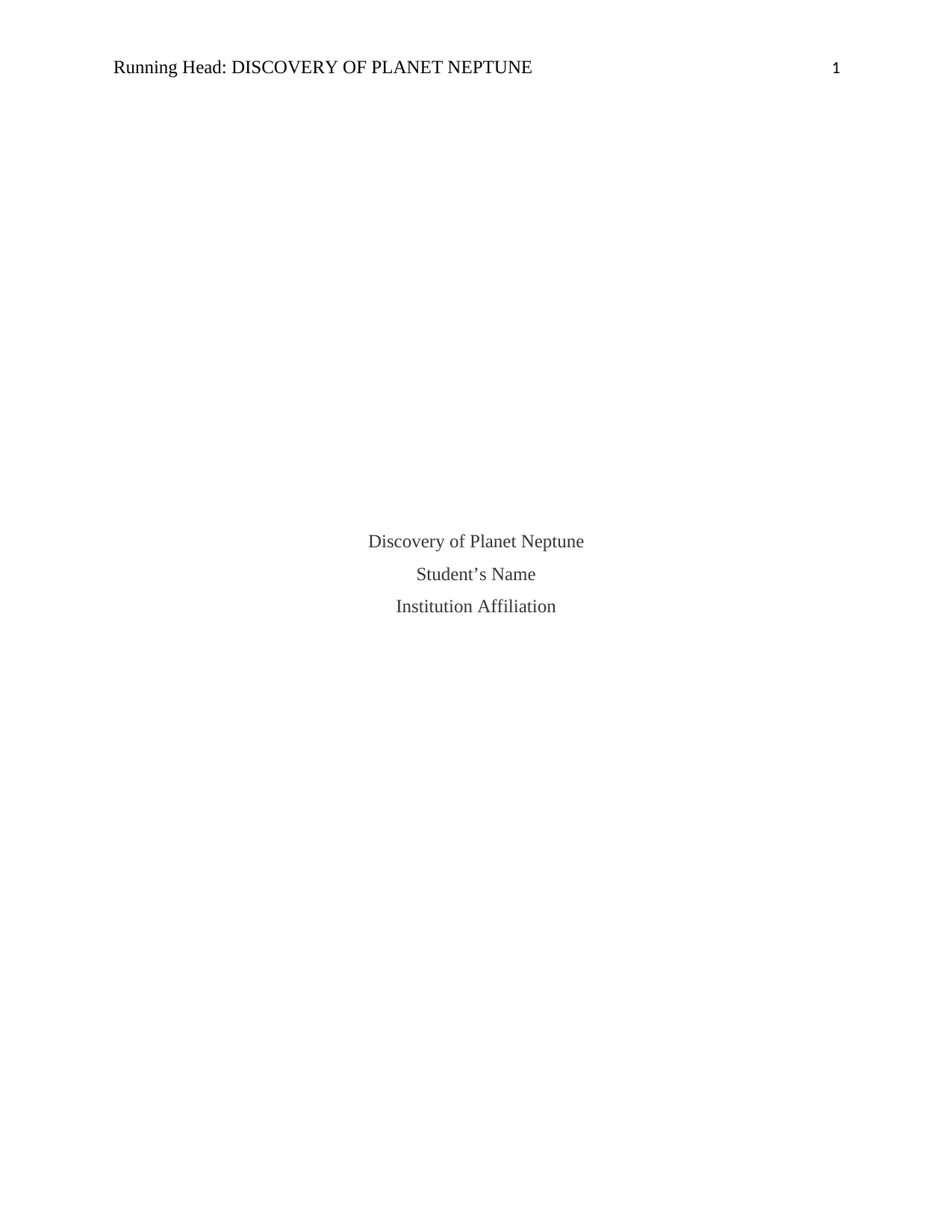
Running Head: DISCOVERY OF PLANET NEPTUNE 1
Discovery of Planet Neptune
Student’s Name
Institution Affiliation
Discovery of Planet Neptune
Student’s Name
Institution Affiliation
Paraphrase This Document
Need a fresh take? Get an instant paraphrase of this document with our AI Paraphraser

DISCOVERY Of PLANET NEPTUNE 2
Abstract
This paper seeks to expound and critically analyze the planet Neptune. This includes the
person that discovered it, the time he found it, and how he saw it. The analyzed paper then
explains if there is concrete evidence too if the Planet Neptune does exist. Then it further goes
ahead and provides insightful sources to support the evidence presented, however, on the other
hand, it also shows sources which contradict the reality.
Abstract
This paper seeks to expound and critically analyze the planet Neptune. This includes the
person that discovered it, the time he found it, and how he saw it. The analyzed paper then
explains if there is concrete evidence too if the Planet Neptune does exist. Then it further goes
ahead and provides insightful sources to support the evidence presented, however, on the other
hand, it also shows sources which contradict the reality.
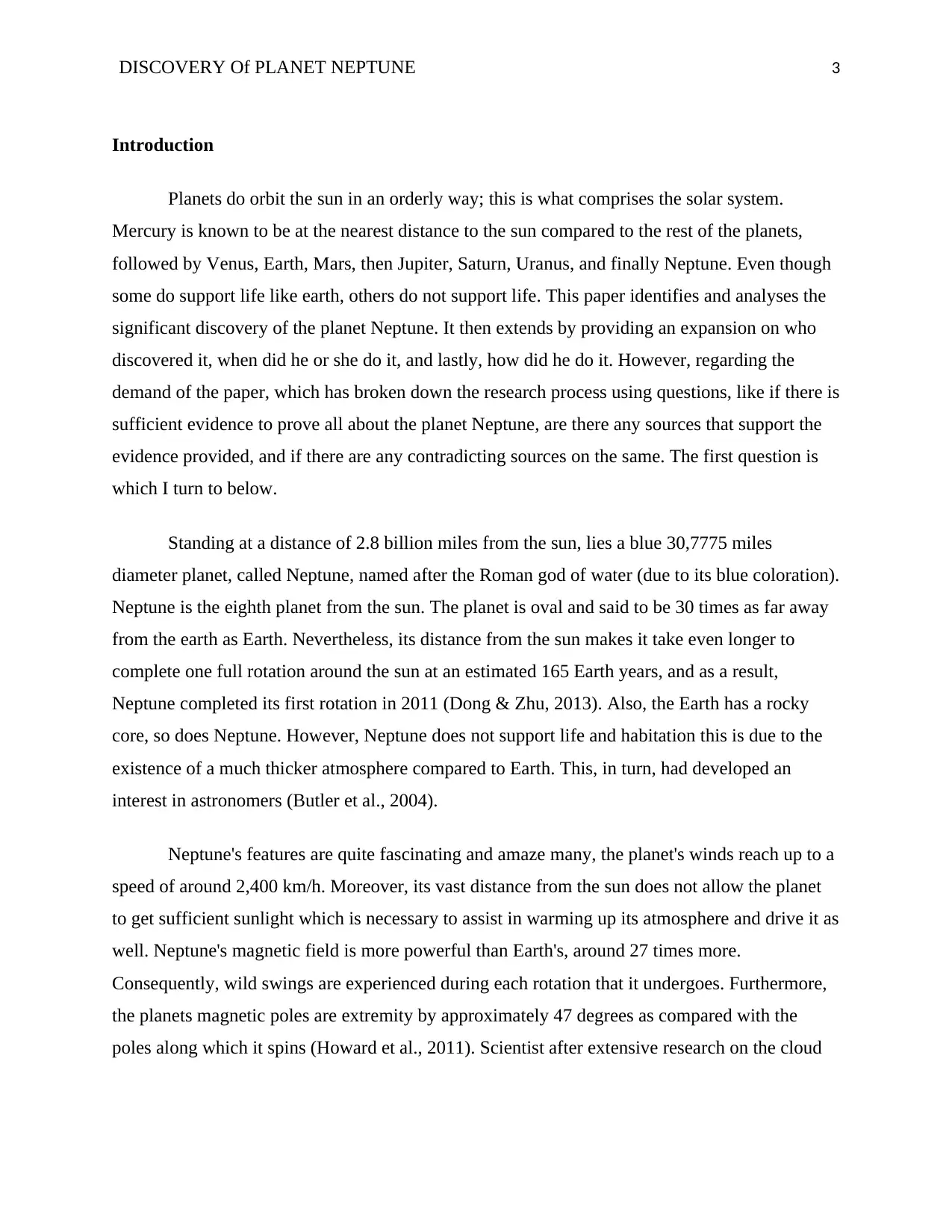
DISCOVERY Of PLANET NEPTUNE 3
Introduction
Planets do orbit the sun in an orderly way; this is what comprises the solar system.
Mercury is known to be at the nearest distance to the sun compared to the rest of the planets,
followed by Venus, Earth, Mars, then Jupiter, Saturn, Uranus, and finally Neptune. Even though
some do support life like earth, others do not support life. This paper identifies and analyses the
significant discovery of the planet Neptune. It then extends by providing an expansion on who
discovered it, when did he or she do it, and lastly, how did he do it. However, regarding the
demand of the paper, which has broken down the research process using questions, like if there is
sufficient evidence to prove all about the planet Neptune, are there any sources that support the
evidence provided, and if there are any contradicting sources on the same. The first question is
which I turn to below.
Standing at a distance of 2.8 billion miles from the sun, lies a blue 30,7775 miles
diameter planet, called Neptune, named after the Roman god of water (due to its blue coloration).
Neptune is the eighth planet from the sun. The planet is oval and said to be 30 times as far away
from the earth as Earth. Nevertheless, its distance from the sun makes it take even longer to
complete one full rotation around the sun at an estimated 165 Earth years, and as a result,
Neptune completed its first rotation in 2011 (Dong & Zhu, 2013). Also, the Earth has a rocky
core, so does Neptune. However, Neptune does not support life and habitation this is due to the
existence of a much thicker atmosphere compared to Earth. This, in turn, had developed an
interest in astronomers (Butler et al., 2004).
Neptune's features are quite fascinating and amaze many, the planet's winds reach up to a
speed of around 2,400 km/h. Moreover, its vast distance from the sun does not allow the planet
to get sufficient sunlight which is necessary to assist in warming up its atmosphere and drive it as
well. Neptune's magnetic field is more powerful than Earth's, around 27 times more.
Consequently, wild swings are experienced during each rotation that it undergoes. Furthermore,
the planets magnetic poles are extremity by approximately 47 degrees as compared with the
poles along which it spins (Howard et al., 2011). Scientist after extensive research on the cloud
Introduction
Planets do orbit the sun in an orderly way; this is what comprises the solar system.
Mercury is known to be at the nearest distance to the sun compared to the rest of the planets,
followed by Venus, Earth, Mars, then Jupiter, Saturn, Uranus, and finally Neptune. Even though
some do support life like earth, others do not support life. This paper identifies and analyses the
significant discovery of the planet Neptune. It then extends by providing an expansion on who
discovered it, when did he or she do it, and lastly, how did he do it. However, regarding the
demand of the paper, which has broken down the research process using questions, like if there is
sufficient evidence to prove all about the planet Neptune, are there any sources that support the
evidence provided, and if there are any contradicting sources on the same. The first question is
which I turn to below.
Standing at a distance of 2.8 billion miles from the sun, lies a blue 30,7775 miles
diameter planet, called Neptune, named after the Roman god of water (due to its blue coloration).
Neptune is the eighth planet from the sun. The planet is oval and said to be 30 times as far away
from the earth as Earth. Nevertheless, its distance from the sun makes it take even longer to
complete one full rotation around the sun at an estimated 165 Earth years, and as a result,
Neptune completed its first rotation in 2011 (Dong & Zhu, 2013). Also, the Earth has a rocky
core, so does Neptune. However, Neptune does not support life and habitation this is due to the
existence of a much thicker atmosphere compared to Earth. This, in turn, had developed an
interest in astronomers (Butler et al., 2004).
Neptune's features are quite fascinating and amaze many, the planet's winds reach up to a
speed of around 2,400 km/h. Moreover, its vast distance from the sun does not allow the planet
to get sufficient sunlight which is necessary to assist in warming up its atmosphere and drive it as
well. Neptune's magnetic field is more powerful than Earth's, around 27 times more.
Consequently, wild swings are experienced during each rotation that it undergoes. Furthermore,
the planets magnetic poles are extremity by approximately 47 degrees as compared with the
poles along which it spins (Howard et al., 2011). Scientist after extensive research on the cloud
⊘ This is a preview!⊘
Do you want full access?
Subscribe today to unlock all pages.

Trusted by 1+ million students worldwide
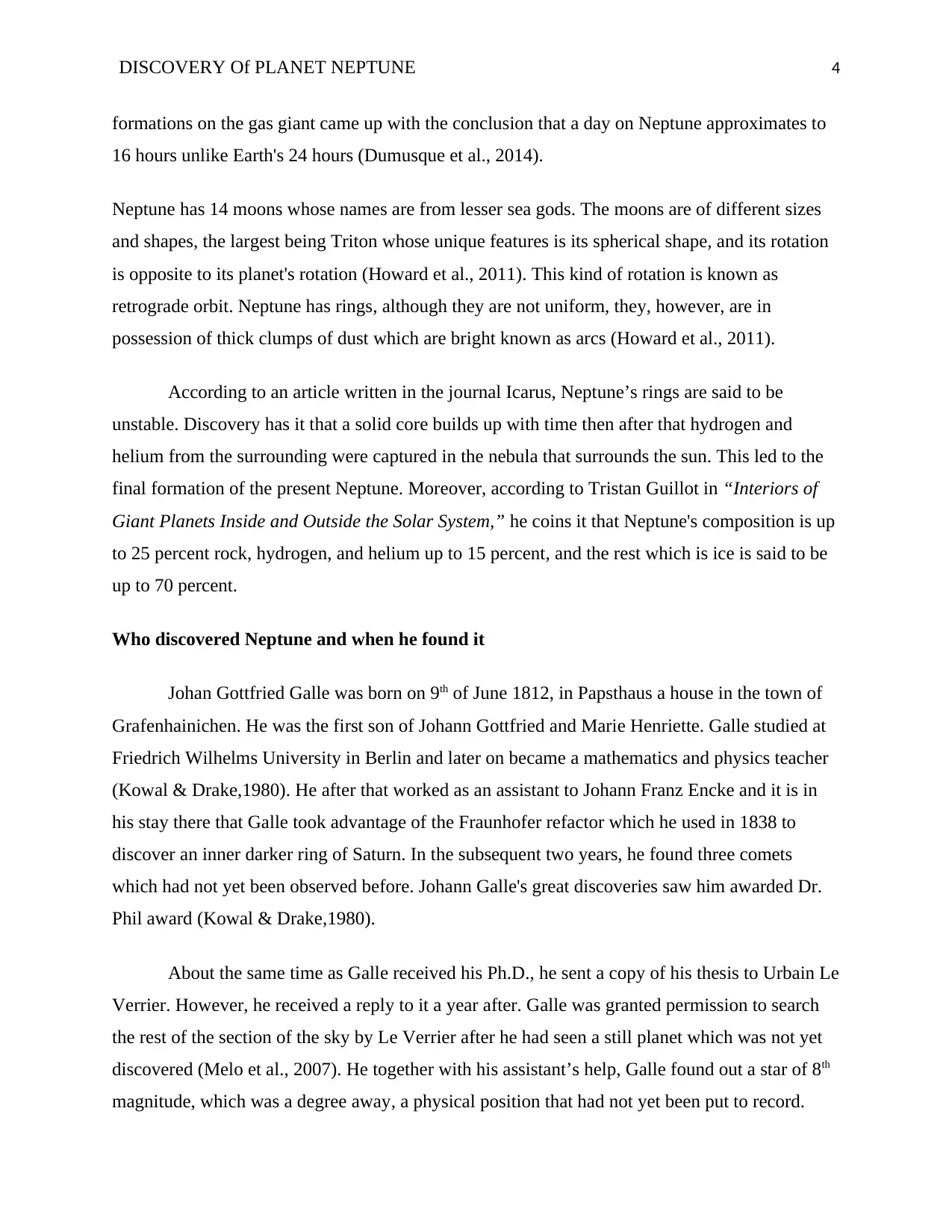
DISCOVERY Of PLANET NEPTUNE 4
formations on the gas giant came up with the conclusion that a day on Neptune approximates to
16 hours unlike Earth's 24 hours (Dumusque et al., 2014).
Neptune has 14 moons whose names are from lesser sea gods. The moons are of different sizes
and shapes, the largest being Triton whose unique features is its spherical shape, and its rotation
is opposite to its planet's rotation (Howard et al., 2011). This kind of rotation is known as
retrograde orbit. Neptune has rings, although they are not uniform, they, however, are in
possession of thick clumps of dust which are bright known as arcs (Howard et al., 2011).
According to an article written in the journal Icarus, Neptune’s rings are said to be
unstable. Discovery has it that a solid core builds up with time then after that hydrogen and
helium from the surrounding were captured in the nebula that surrounds the sun. This led to the
final formation of the present Neptune. Moreover, according to Tristan Guillot in “Interiors of
Giant Planets Inside and Outside the Solar System,” he coins it that Neptune's composition is up
to 25 percent rock, hydrogen, and helium up to 15 percent, and the rest which is ice is said to be
up to 70 percent.
Who discovered Neptune and when he found it
Johan Gottfried Galle was born on 9th of June 1812, in Papsthaus a house in the town of
Grafenhainichen. He was the first son of Johann Gottfried and Marie Henriette. Galle studied at
Friedrich Wilhelms University in Berlin and later on became a mathematics and physics teacher
(Kowal & Drake,1980). He after that worked as an assistant to Johann Franz Encke and it is in
his stay there that Galle took advantage of the Fraunhofer refactor which he used in 1838 to
discover an inner darker ring of Saturn. In the subsequent two years, he found three comets
which had not yet been observed before. Johann Galle's great discoveries saw him awarded Dr.
Phil award (Kowal & Drake,1980).
About the same time as Galle received his Ph.D., he sent a copy of his thesis to Urbain Le
Verrier. However, he received a reply to it a year after. Galle was granted permission to search
the rest of the section of the sky by Le Verrier after he had seen a still planet which was not yet
discovered (Melo et al., 2007). He together with his assistant’s help, Galle found out a star of 8th
magnitude, which was a degree away, a physical position that had not yet been put to record.
formations on the gas giant came up with the conclusion that a day on Neptune approximates to
16 hours unlike Earth's 24 hours (Dumusque et al., 2014).
Neptune has 14 moons whose names are from lesser sea gods. The moons are of different sizes
and shapes, the largest being Triton whose unique features is its spherical shape, and its rotation
is opposite to its planet's rotation (Howard et al., 2011). This kind of rotation is known as
retrograde orbit. Neptune has rings, although they are not uniform, they, however, are in
possession of thick clumps of dust which are bright known as arcs (Howard et al., 2011).
According to an article written in the journal Icarus, Neptune’s rings are said to be
unstable. Discovery has it that a solid core builds up with time then after that hydrogen and
helium from the surrounding were captured in the nebula that surrounds the sun. This led to the
final formation of the present Neptune. Moreover, according to Tristan Guillot in “Interiors of
Giant Planets Inside and Outside the Solar System,” he coins it that Neptune's composition is up
to 25 percent rock, hydrogen, and helium up to 15 percent, and the rest which is ice is said to be
up to 70 percent.
Who discovered Neptune and when he found it
Johan Gottfried Galle was born on 9th of June 1812, in Papsthaus a house in the town of
Grafenhainichen. He was the first son of Johann Gottfried and Marie Henriette. Galle studied at
Friedrich Wilhelms University in Berlin and later on became a mathematics and physics teacher
(Kowal & Drake,1980). He after that worked as an assistant to Johann Franz Encke and it is in
his stay there that Galle took advantage of the Fraunhofer refactor which he used in 1838 to
discover an inner darker ring of Saturn. In the subsequent two years, he found three comets
which had not yet been observed before. Johann Galle's great discoveries saw him awarded Dr.
Phil award (Kowal & Drake,1980).
About the same time as Galle received his Ph.D., he sent a copy of his thesis to Urbain Le
Verrier. However, he received a reply to it a year after. Galle was granted permission to search
the rest of the section of the sky by Le Verrier after he had seen a still planet which was not yet
discovered (Melo et al., 2007). He together with his assistant’s help, Galle found out a star of 8th
magnitude, which was a degree away, a physical position that had not yet been put to record.
Paraphrase This Document
Need a fresh take? Get an instant paraphrase of this document with our AI Paraphraser
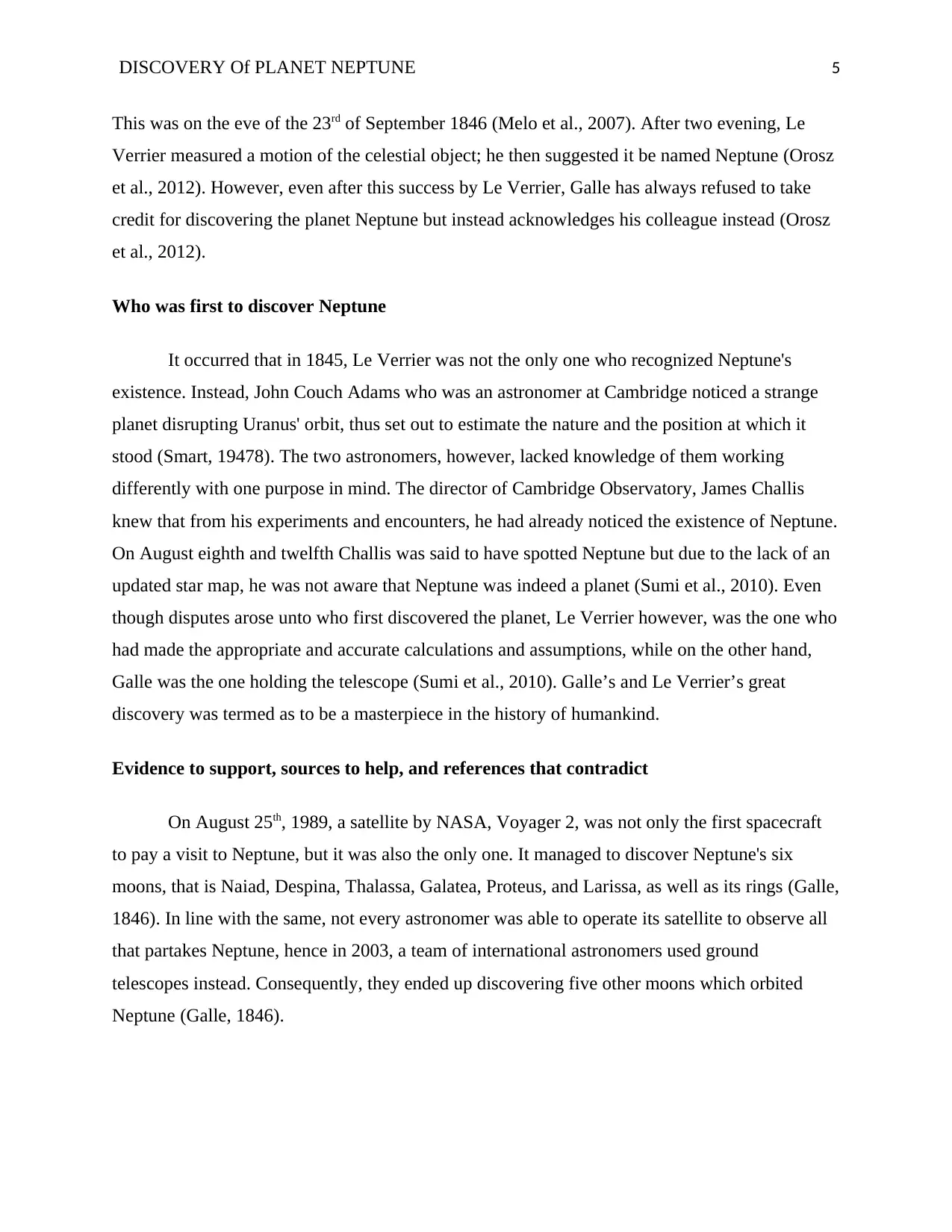
DISCOVERY Of PLANET NEPTUNE 5
This was on the eve of the 23rd of September 1846 (Melo et al., 2007). After two evening, Le
Verrier measured a motion of the celestial object; he then suggested it be named Neptune (Orosz
et al., 2012). However, even after this success by Le Verrier, Galle has always refused to take
credit for discovering the planet Neptune but instead acknowledges his colleague instead (Orosz
et al., 2012).
Who was first to discover Neptune
It occurred that in 1845, Le Verrier was not the only one who recognized Neptune's
existence. Instead, John Couch Adams who was an astronomer at Cambridge noticed a strange
planet disrupting Uranus' orbit, thus set out to estimate the nature and the position at which it
stood (Smart, 19478). The two astronomers, however, lacked knowledge of them working
differently with one purpose in mind. The director of Cambridge Observatory, James Challis
knew that from his experiments and encounters, he had already noticed the existence of Neptune.
On August eighth and twelfth Challis was said to have spotted Neptune but due to the lack of an
updated star map, he was not aware that Neptune was indeed a planet (Sumi et al., 2010). Even
though disputes arose unto who first discovered the planet, Le Verrier however, was the one who
had made the appropriate and accurate calculations and assumptions, while on the other hand,
Galle was the one holding the telescope (Sumi et al., 2010). Galle’s and Le Verrier’s great
discovery was termed as to be a masterpiece in the history of humankind.
Evidence to support, sources to help, and references that contradict
On August 25th, 1989, a satellite by NASA, Voyager 2, was not only the first spacecraft
to pay a visit to Neptune, but it was also the only one. It managed to discover Neptune's six
moons, that is Naiad, Despina, Thalassa, Galatea, Proteus, and Larissa, as well as its rings (Galle,
1846). In line with the same, not every astronomer was able to operate its satellite to observe all
that partakes Neptune, hence in 2003, a team of international astronomers used ground
telescopes instead. Consequently, they ended up discovering five other moons which orbited
Neptune (Galle, 1846).
This was on the eve of the 23rd of September 1846 (Melo et al., 2007). After two evening, Le
Verrier measured a motion of the celestial object; he then suggested it be named Neptune (Orosz
et al., 2012). However, even after this success by Le Verrier, Galle has always refused to take
credit for discovering the planet Neptune but instead acknowledges his colleague instead (Orosz
et al., 2012).
Who was first to discover Neptune
It occurred that in 1845, Le Verrier was not the only one who recognized Neptune's
existence. Instead, John Couch Adams who was an astronomer at Cambridge noticed a strange
planet disrupting Uranus' orbit, thus set out to estimate the nature and the position at which it
stood (Smart, 19478). The two astronomers, however, lacked knowledge of them working
differently with one purpose in mind. The director of Cambridge Observatory, James Challis
knew that from his experiments and encounters, he had already noticed the existence of Neptune.
On August eighth and twelfth Challis was said to have spotted Neptune but due to the lack of an
updated star map, he was not aware that Neptune was indeed a planet (Sumi et al., 2010). Even
though disputes arose unto who first discovered the planet, Le Verrier however, was the one who
had made the appropriate and accurate calculations and assumptions, while on the other hand,
Galle was the one holding the telescope (Sumi et al., 2010). Galle’s and Le Verrier’s great
discovery was termed as to be a masterpiece in the history of humankind.
Evidence to support, sources to help, and references that contradict
On August 25th, 1989, a satellite by NASA, Voyager 2, was not only the first spacecraft
to pay a visit to Neptune, but it was also the only one. It managed to discover Neptune's six
moons, that is Naiad, Despina, Thalassa, Galatea, Proteus, and Larissa, as well as its rings (Galle,
1846). In line with the same, not every astronomer was able to operate its satellite to observe all
that partakes Neptune, hence in 2003, a team of international astronomers used ground
telescopes instead. Consequently, they ended up discovering five other moons which orbited
Neptune (Galle, 1846).
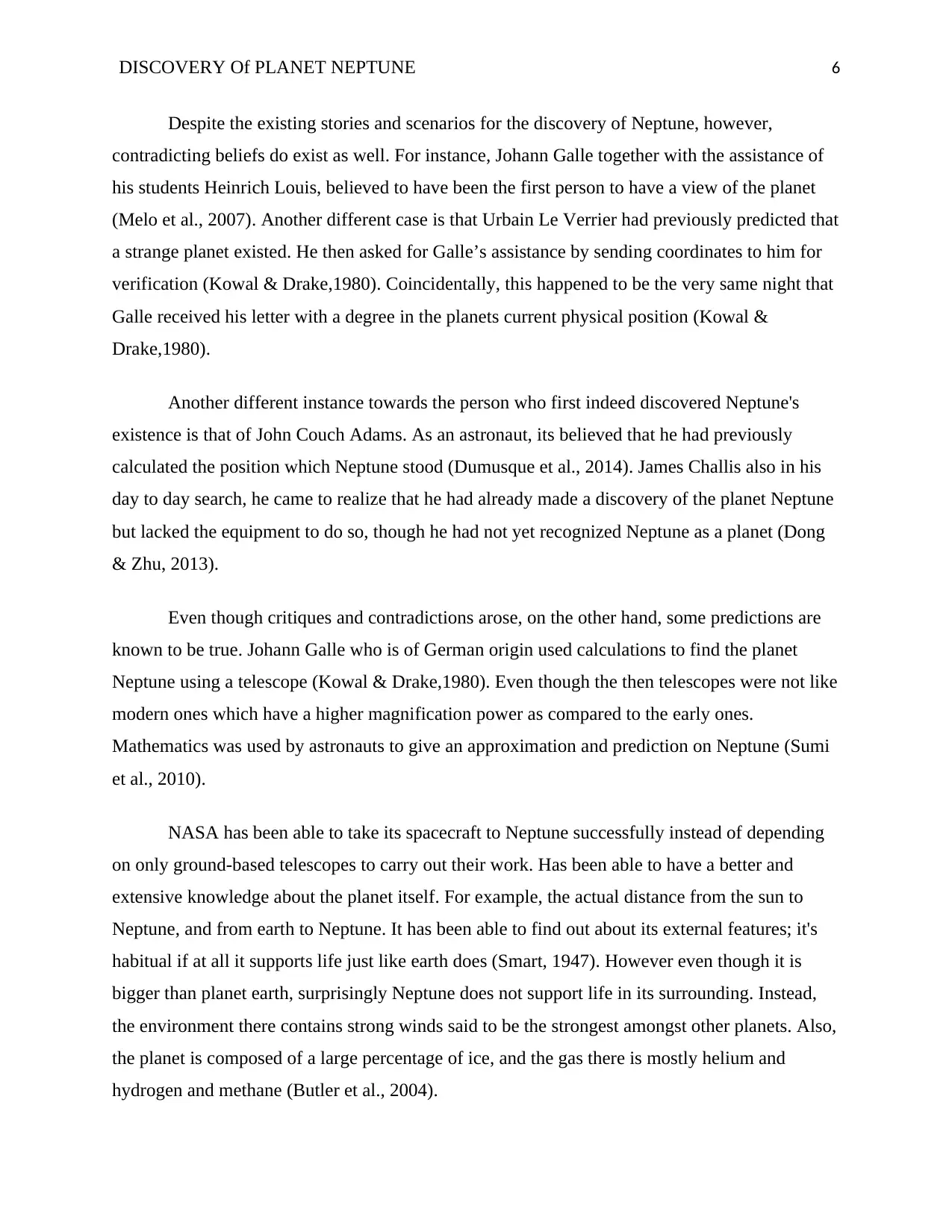
DISCOVERY Of PLANET NEPTUNE 6
Despite the existing stories and scenarios for the discovery of Neptune, however,
contradicting beliefs do exist as well. For instance, Johann Galle together with the assistance of
his students Heinrich Louis, believed to have been the first person to have a view of the planet
(Melo et al., 2007). Another different case is that Urbain Le Verrier had previously predicted that
a strange planet existed. He then asked for Galle’s assistance by sending coordinates to him for
verification (Kowal & Drake,1980). Coincidentally, this happened to be the very same night that
Galle received his letter with a degree in the planets current physical position (Kowal &
Drake,1980).
Another different instance towards the person who first indeed discovered Neptune's
existence is that of John Couch Adams. As an astronaut, its believed that he had previously
calculated the position which Neptune stood (Dumusque et al., 2014). James Challis also in his
day to day search, he came to realize that he had already made a discovery of the planet Neptune
but lacked the equipment to do so, though he had not yet recognized Neptune as a planet (Dong
& Zhu, 2013).
Even though critiques and contradictions arose, on the other hand, some predictions are
known to be true. Johann Galle who is of German origin used calculations to find the planet
Neptune using a telescope (Kowal & Drake,1980). Even though the then telescopes were not like
modern ones which have a higher magnification power as compared to the early ones.
Mathematics was used by astronauts to give an approximation and prediction on Neptune (Sumi
et al., 2010).
NASA has been able to take its spacecraft to Neptune successfully instead of depending
on only ground-based telescopes to carry out their work. Has been able to have a better and
extensive knowledge about the planet itself. For example, the actual distance from the sun to
Neptune, and from earth to Neptune. It has been able to find out about its external features; it's
habitual if at all it supports life just like earth does (Smart, 1947). However even though it is
bigger than planet earth, surprisingly Neptune does not support life in its surrounding. Instead,
the environment there contains strong winds said to be the strongest amongst other planets. Also,
the planet is composed of a large percentage of ice, and the gas there is mostly helium and
hydrogen and methane (Butler et al., 2004).
Despite the existing stories and scenarios for the discovery of Neptune, however,
contradicting beliefs do exist as well. For instance, Johann Galle together with the assistance of
his students Heinrich Louis, believed to have been the first person to have a view of the planet
(Melo et al., 2007). Another different case is that Urbain Le Verrier had previously predicted that
a strange planet existed. He then asked for Galle’s assistance by sending coordinates to him for
verification (Kowal & Drake,1980). Coincidentally, this happened to be the very same night that
Galle received his letter with a degree in the planets current physical position (Kowal &
Drake,1980).
Another different instance towards the person who first indeed discovered Neptune's
existence is that of John Couch Adams. As an astronaut, its believed that he had previously
calculated the position which Neptune stood (Dumusque et al., 2014). James Challis also in his
day to day search, he came to realize that he had already made a discovery of the planet Neptune
but lacked the equipment to do so, though he had not yet recognized Neptune as a planet (Dong
& Zhu, 2013).
Even though critiques and contradictions arose, on the other hand, some predictions are
known to be true. Johann Galle who is of German origin used calculations to find the planet
Neptune using a telescope (Kowal & Drake,1980). Even though the then telescopes were not like
modern ones which have a higher magnification power as compared to the early ones.
Mathematics was used by astronauts to give an approximation and prediction on Neptune (Sumi
et al., 2010).
NASA has been able to take its spacecraft to Neptune successfully instead of depending
on only ground-based telescopes to carry out their work. Has been able to have a better and
extensive knowledge about the planet itself. For example, the actual distance from the sun to
Neptune, and from earth to Neptune. It has been able to find out about its external features; it's
habitual if at all it supports life just like earth does (Smart, 1947). However even though it is
bigger than planet earth, surprisingly Neptune does not support life in its surrounding. Instead,
the environment there contains strong winds said to be the strongest amongst other planets. Also,
the planet is composed of a large percentage of ice, and the gas there is mostly helium and
hydrogen and methane (Butler et al., 2004).
⊘ This is a preview!⊘
Do you want full access?
Subscribe today to unlock all pages.

Trusted by 1+ million students worldwide
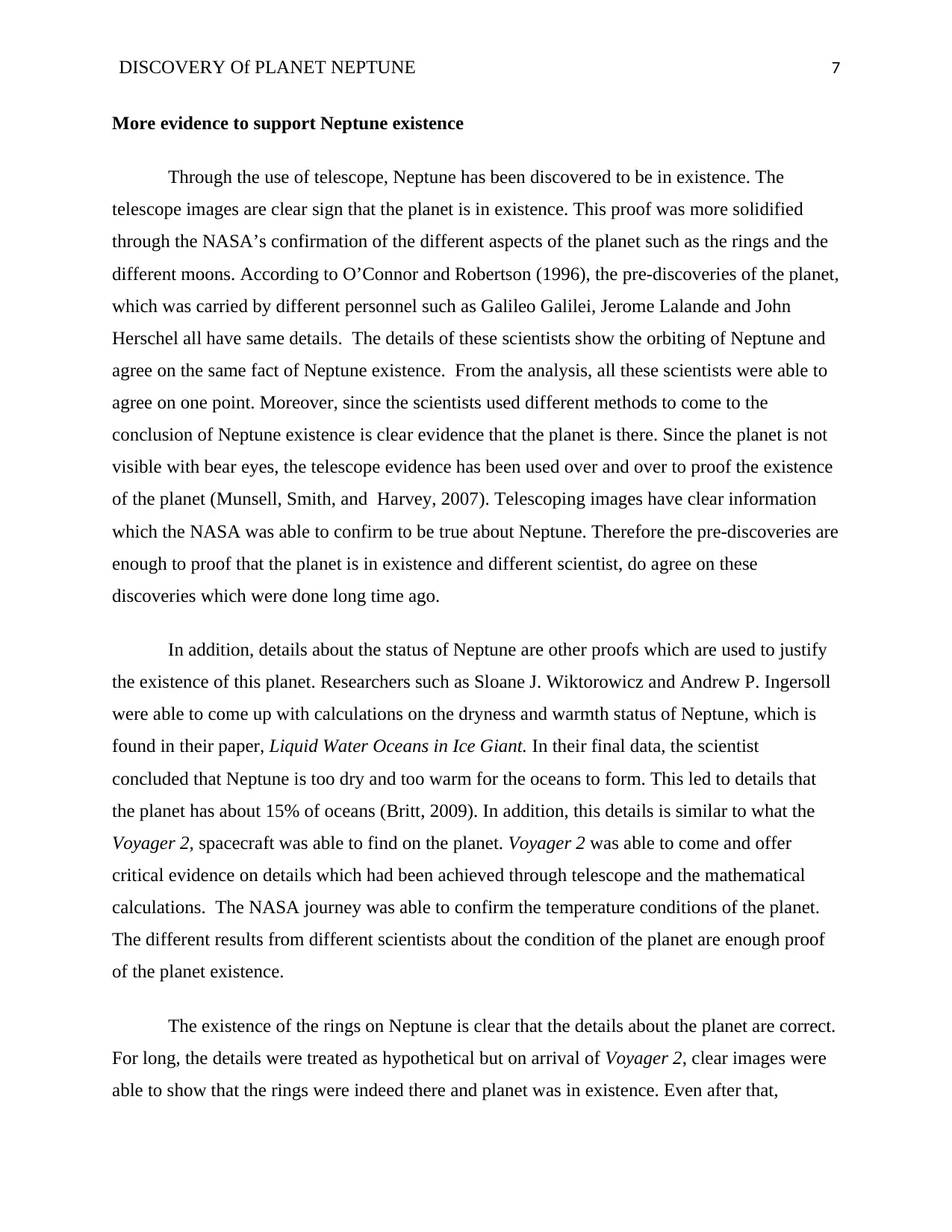
DISCOVERY Of PLANET NEPTUNE 7
More evidence to support Neptune existence
Through the use of telescope, Neptune has been discovered to be in existence. The
telescope images are clear sign that the planet is in existence. This proof was more solidified
through the NASA’s confirmation of the different aspects of the planet such as the rings and the
different moons. According to O’Connor and Robertson (1996), the pre-discoveries of the planet,
which was carried by different personnel such as Galileo Galilei, Jerome Lalande and John
Herschel all have same details. The details of these scientists show the orbiting of Neptune and
agree on the same fact of Neptune existence. From the analysis, all these scientists were able to
agree on one point. Moreover, since the scientists used different methods to come to the
conclusion of Neptune existence is clear evidence that the planet is there. Since the planet is not
visible with bear eyes, the telescope evidence has been used over and over to proof the existence
of the planet (Munsell, Smith, and Harvey, 2007). Telescoping images have clear information
which the NASA was able to confirm to be true about Neptune. Therefore the pre-discoveries are
enough to proof that the planet is in existence and different scientist, do agree on these
discoveries which were done long time ago.
In addition, details about the status of Neptune are other proofs which are used to justify
the existence of this planet. Researchers such as Sloane J. Wiktorowicz and Andrew P. Ingersoll
were able to come up with calculations on the dryness and warmth status of Neptune, which is
found in their paper, Liquid Water Oceans in Ice Giant. In their final data, the scientist
concluded that Neptune is too dry and too warm for the oceans to form. This led to details that
the planet has about 15% of oceans (Britt, 2009). In addition, this details is similar to what the
Voyager 2, spacecraft was able to find on the planet. Voyager 2 was able to come and offer
critical evidence on details which had been achieved through telescope and the mathematical
calculations. The NASA journey was able to confirm the temperature conditions of the planet.
The different results from different scientists about the condition of the planet are enough proof
of the planet existence.
The existence of the rings on Neptune is clear that the details about the planet are correct.
For long, the details were treated as hypothetical but on arrival of Voyager 2, clear images were
able to show that the rings were indeed there and planet was in existence. Even after that,
More evidence to support Neptune existence
Through the use of telescope, Neptune has been discovered to be in existence. The
telescope images are clear sign that the planet is in existence. This proof was more solidified
through the NASA’s confirmation of the different aspects of the planet such as the rings and the
different moons. According to O’Connor and Robertson (1996), the pre-discoveries of the planet,
which was carried by different personnel such as Galileo Galilei, Jerome Lalande and John
Herschel all have same details. The details of these scientists show the orbiting of Neptune and
agree on the same fact of Neptune existence. From the analysis, all these scientists were able to
agree on one point. Moreover, since the scientists used different methods to come to the
conclusion of Neptune existence is clear evidence that the planet is there. Since the planet is not
visible with bear eyes, the telescope evidence has been used over and over to proof the existence
of the planet (Munsell, Smith, and Harvey, 2007). Telescoping images have clear information
which the NASA was able to confirm to be true about Neptune. Therefore the pre-discoveries are
enough to proof that the planet is in existence and different scientist, do agree on these
discoveries which were done long time ago.
In addition, details about the status of Neptune are other proofs which are used to justify
the existence of this planet. Researchers such as Sloane J. Wiktorowicz and Andrew P. Ingersoll
were able to come up with calculations on the dryness and warmth status of Neptune, which is
found in their paper, Liquid Water Oceans in Ice Giant. In their final data, the scientist
concluded that Neptune is too dry and too warm for the oceans to form. This led to details that
the planet has about 15% of oceans (Britt, 2009). In addition, this details is similar to what the
Voyager 2, spacecraft was able to find on the planet. Voyager 2 was able to come and offer
critical evidence on details which had been achieved through telescope and the mathematical
calculations. The NASA journey was able to confirm the temperature conditions of the planet.
The different results from different scientists about the condition of the planet are enough proof
of the planet existence.
The existence of the rings on Neptune is clear that the details about the planet are correct.
For long, the details were treated as hypothetical but on arrival of Voyager 2, clear images were
able to show that the rings were indeed there and planet was in existence. Even after that,
Paraphrase This Document
Need a fresh take? Get an instant paraphrase of this document with our AI Paraphraser
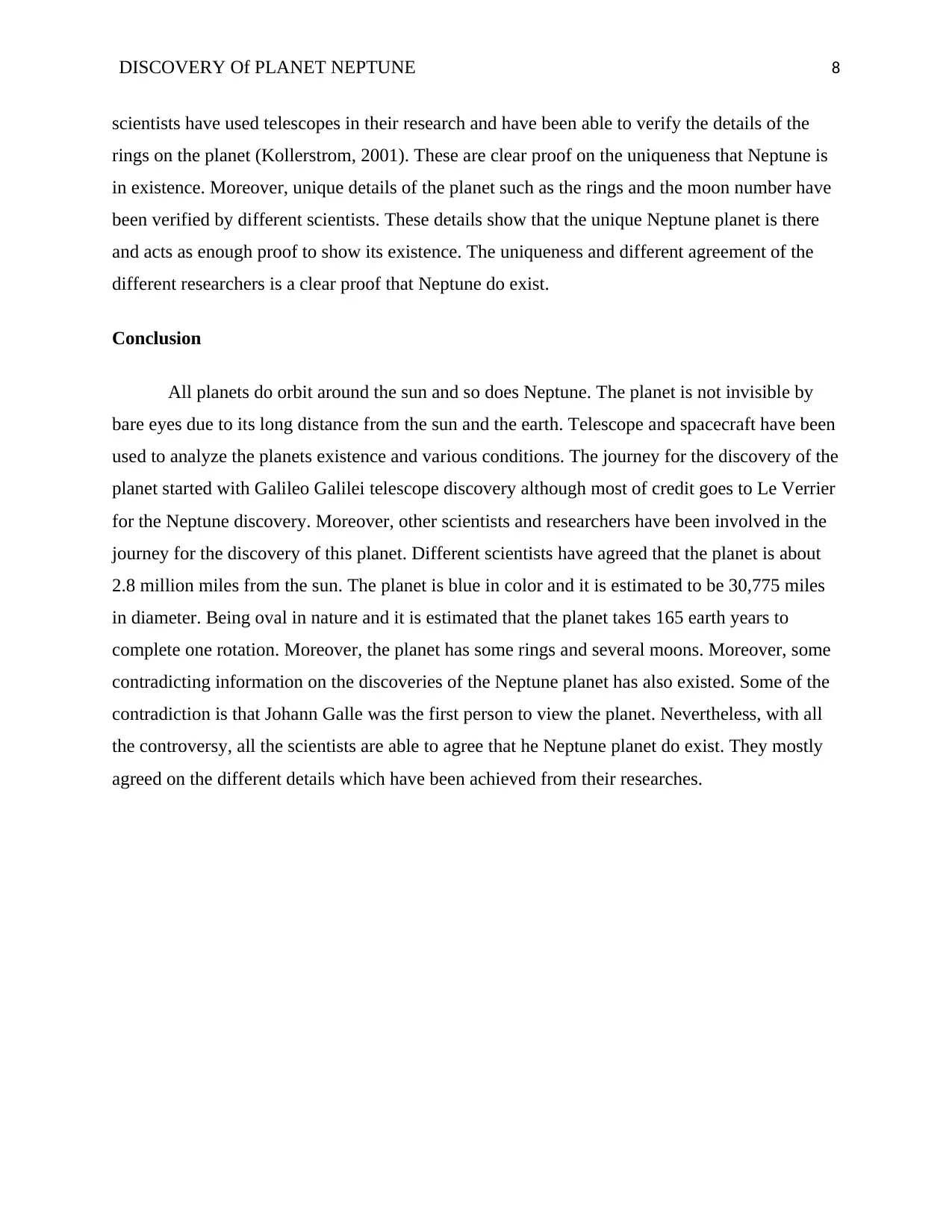
DISCOVERY Of PLANET NEPTUNE 8
scientists have used telescopes in their research and have been able to verify the details of the
rings on the planet (Kollerstrom, 2001). These are clear proof on the uniqueness that Neptune is
in existence. Moreover, unique details of the planet such as the rings and the moon number have
been verified by different scientists. These details show that the unique Neptune planet is there
and acts as enough proof to show its existence. The uniqueness and different agreement of the
different researchers is a clear proof that Neptune do exist.
Conclusion
All planets do orbit around the sun and so does Neptune. The planet is not invisible by
bare eyes due to its long distance from the sun and the earth. Telescope and spacecraft have been
used to analyze the planets existence and various conditions. The journey for the discovery of the
planet started with Galileo Galilei telescope discovery although most of credit goes to Le Verrier
for the Neptune discovery. Moreover, other scientists and researchers have been involved in the
journey for the discovery of this planet. Different scientists have agreed that the planet is about
2.8 million miles from the sun. The planet is blue in color and it is estimated to be 30,775 miles
in diameter. Being oval in nature and it is estimated that the planet takes 165 earth years to
complete one rotation. Moreover, the planet has some rings and several moons. Moreover, some
contradicting information on the discoveries of the Neptune planet has also existed. Some of the
contradiction is that Johann Galle was the first person to view the planet. Nevertheless, with all
the controversy, all the scientists are able to agree that he Neptune planet do exist. They mostly
agreed on the different details which have been achieved from their researches.
scientists have used telescopes in their research and have been able to verify the details of the
rings on the planet (Kollerstrom, 2001). These are clear proof on the uniqueness that Neptune is
in existence. Moreover, unique details of the planet such as the rings and the moon number have
been verified by different scientists. These details show that the unique Neptune planet is there
and acts as enough proof to show its existence. The uniqueness and different agreement of the
different researchers is a clear proof that Neptune do exist.
Conclusion
All planets do orbit around the sun and so does Neptune. The planet is not invisible by
bare eyes due to its long distance from the sun and the earth. Telescope and spacecraft have been
used to analyze the planets existence and various conditions. The journey for the discovery of the
planet started with Galileo Galilei telescope discovery although most of credit goes to Le Verrier
for the Neptune discovery. Moreover, other scientists and researchers have been involved in the
journey for the discovery of this planet. Different scientists have agreed that the planet is about
2.8 million miles from the sun. The planet is blue in color and it is estimated to be 30,775 miles
in diameter. Being oval in nature and it is estimated that the planet takes 165 earth years to
complete one rotation. Moreover, the planet has some rings and several moons. Moreover, some
contradicting information on the discoveries of the Neptune planet has also existed. Some of the
contradiction is that Johann Galle was the first person to view the planet. Nevertheless, with all
the controversy, all the scientists are able to agree that he Neptune planet do exist. They mostly
agreed on the different details which have been achieved from their researches.
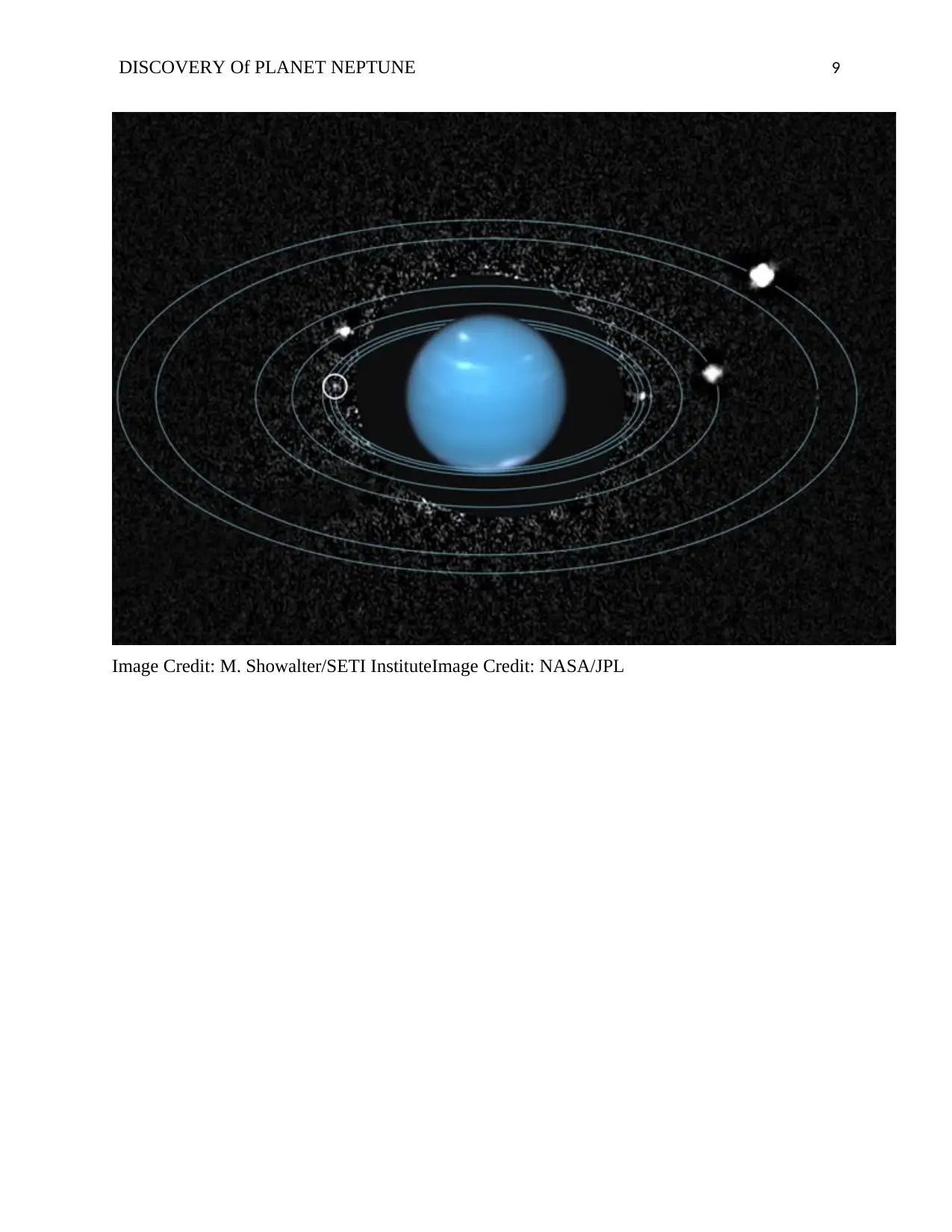
DISCOVERY Of PLANET NEPTUNE 9
Image Credit: M. Showalter/SETI InstituteImage Credit: NASA/JPL
Image Credit: M. Showalter/SETI InstituteImage Credit: NASA/JPL
⊘ This is a preview!⊘
Do you want full access?
Subscribe today to unlock all pages.

Trusted by 1+ million students worldwide
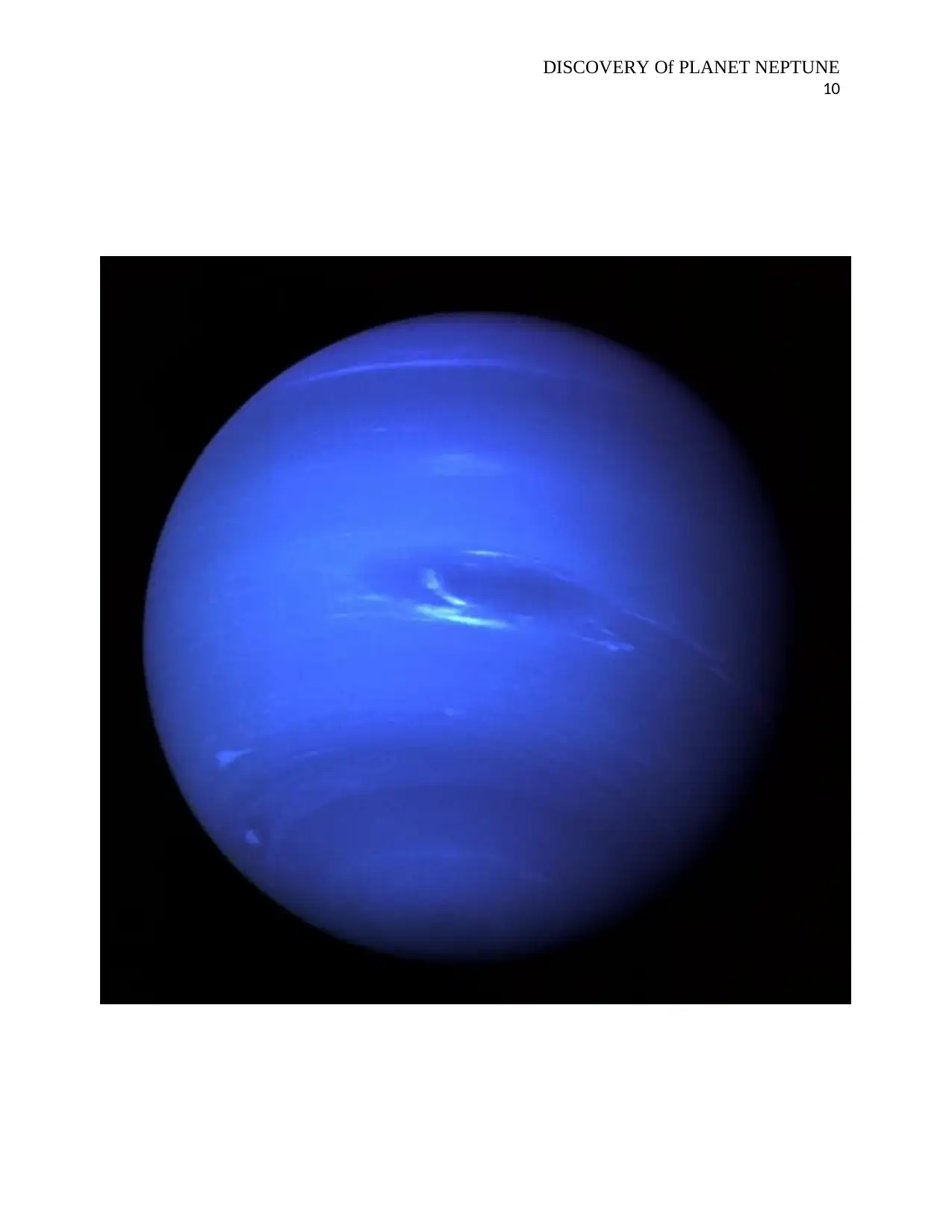
DISCOVERY Of PLANET NEPTUNE
10
10
Paraphrase This Document
Need a fresh take? Get an instant paraphrase of this document with our AI Paraphraser
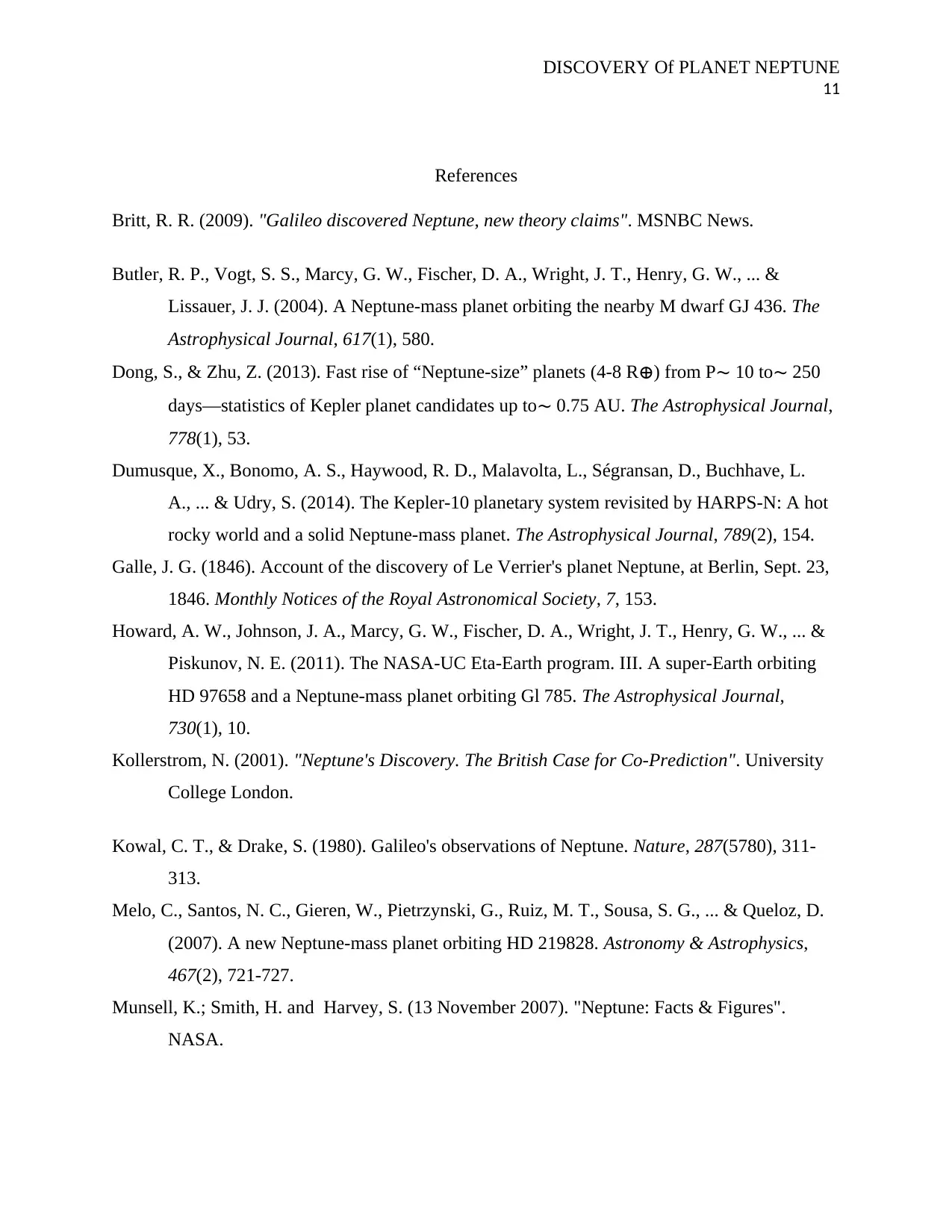
DISCOVERY Of PLANET NEPTUNE
11
References
Britt, R. R. (2009). "Galileo discovered Neptune, new theory claims". MSNBC News.
Butler, R. P., Vogt, S. S., Marcy, G. W., Fischer, D. A., Wright, J. T., Henry, G. W., ... &
Lissauer, J. J. (2004). A Neptune-mass planet orbiting the nearby M dwarf GJ 436. The
Astrophysical Journal, 617(1), 580.
Dong, S., & Zhu, Z. (2013). Fast rise of “Neptune-size” planets (4-8 R⊕) from P∼ 10 to∼ 250
days—statistics of Kepler planet candidates up to∼ 0.75 AU. The Astrophysical Journal,
778(1), 53.
Dumusque, X., Bonomo, A. S., Haywood, R. D., Malavolta, L., Ségransan, D., Buchhave, L.
A., ... & Udry, S. (2014). The Kepler-10 planetary system revisited by HARPS-N: A hot
rocky world and a solid Neptune-mass planet. The Astrophysical Journal, 789(2), 154.
Galle, J. G. (1846). Account of the discovery of Le Verrier's planet Neptune, at Berlin, Sept. 23,
1846. Monthly Notices of the Royal Astronomical Society, 7, 153.
Howard, A. W., Johnson, J. A., Marcy, G. W., Fischer, D. A., Wright, J. T., Henry, G. W., ... &
Piskunov, N. E. (2011). The NASA-UC Eta-Earth program. III. A super-Earth orbiting
HD 97658 and a Neptune-mass planet orbiting Gl 785. The Astrophysical Journal,
730(1), 10.
Kollerstrom, N. (2001). "Neptune's Discovery. The British Case for Co-Prediction". University
College London.
Kowal, C. T., & Drake, S. (1980). Galileo's observations of Neptune. Nature, 287(5780), 311-
313.
Melo, C., Santos, N. C., Gieren, W., Pietrzynski, G., Ruiz, M. T., Sousa, S. G., ... & Queloz, D.
(2007). A new Neptune-mass planet orbiting HD 219828. Astronomy & Astrophysics,
467(2), 721-727.
Munsell, K.; Smith, H. and Harvey, S. (13 November 2007). "Neptune: Facts & Figures".
NASA.
11
References
Britt, R. R. (2009). "Galileo discovered Neptune, new theory claims". MSNBC News.
Butler, R. P., Vogt, S. S., Marcy, G. W., Fischer, D. A., Wright, J. T., Henry, G. W., ... &
Lissauer, J. J. (2004). A Neptune-mass planet orbiting the nearby M dwarf GJ 436. The
Astrophysical Journal, 617(1), 580.
Dong, S., & Zhu, Z. (2013). Fast rise of “Neptune-size” planets (4-8 R⊕) from P∼ 10 to∼ 250
days—statistics of Kepler planet candidates up to∼ 0.75 AU. The Astrophysical Journal,
778(1), 53.
Dumusque, X., Bonomo, A. S., Haywood, R. D., Malavolta, L., Ségransan, D., Buchhave, L.
A., ... & Udry, S. (2014). The Kepler-10 planetary system revisited by HARPS-N: A hot
rocky world and a solid Neptune-mass planet. The Astrophysical Journal, 789(2), 154.
Galle, J. G. (1846). Account of the discovery of Le Verrier's planet Neptune, at Berlin, Sept. 23,
1846. Monthly Notices of the Royal Astronomical Society, 7, 153.
Howard, A. W., Johnson, J. A., Marcy, G. W., Fischer, D. A., Wright, J. T., Henry, G. W., ... &
Piskunov, N. E. (2011). The NASA-UC Eta-Earth program. III. A super-Earth orbiting
HD 97658 and a Neptune-mass planet orbiting Gl 785. The Astrophysical Journal,
730(1), 10.
Kollerstrom, N. (2001). "Neptune's Discovery. The British Case for Co-Prediction". University
College London.
Kowal, C. T., & Drake, S. (1980). Galileo's observations of Neptune. Nature, 287(5780), 311-
313.
Melo, C., Santos, N. C., Gieren, W., Pietrzynski, G., Ruiz, M. T., Sousa, S. G., ... & Queloz, D.
(2007). A new Neptune-mass planet orbiting HD 219828. Astronomy & Astrophysics,
467(2), 721-727.
Munsell, K.; Smith, H. and Harvey, S. (13 November 2007). "Neptune: Facts & Figures".
NASA.
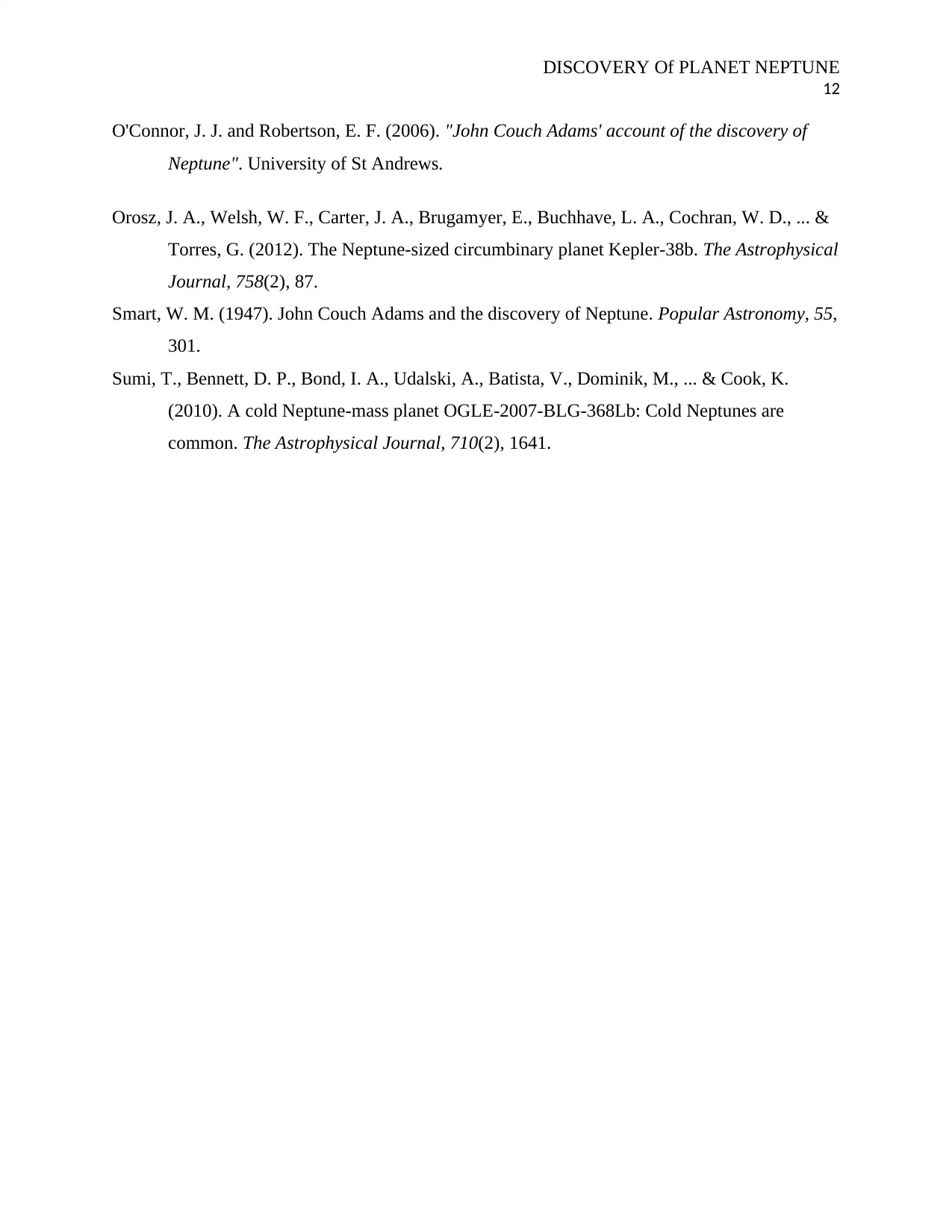
DISCOVERY Of PLANET NEPTUNE
12
O'Connor, J. J. and Robertson, E. F. (2006). "John Couch Adams' account of the discovery of
Neptune". University of St Andrews.
Orosz, J. A., Welsh, W. F., Carter, J. A., Brugamyer, E., Buchhave, L. A., Cochran, W. D., ... &
Torres, G. (2012). The Neptune-sized circumbinary planet Kepler-38b. The Astrophysical
Journal, 758(2), 87.
Smart, W. M. (1947). John Couch Adams and the discovery of Neptune. Popular Astronomy, 55,
301.
Sumi, T., Bennett, D. P., Bond, I. A., Udalski, A., Batista, V., Dominik, M., ... & Cook, K.
(2010). A cold Neptune-mass planet OGLE-2007-BLG-368Lb: Cold Neptunes are
common. The Astrophysical Journal, 710(2), 1641.
12
O'Connor, J. J. and Robertson, E. F. (2006). "John Couch Adams' account of the discovery of
Neptune". University of St Andrews.
Orosz, J. A., Welsh, W. F., Carter, J. A., Brugamyer, E., Buchhave, L. A., Cochran, W. D., ... &
Torres, G. (2012). The Neptune-sized circumbinary planet Kepler-38b. The Astrophysical
Journal, 758(2), 87.
Smart, W. M. (1947). John Couch Adams and the discovery of Neptune. Popular Astronomy, 55,
301.
Sumi, T., Bennett, D. P., Bond, I. A., Udalski, A., Batista, V., Dominik, M., ... & Cook, K.
(2010). A cold Neptune-mass planet OGLE-2007-BLG-368Lb: Cold Neptunes are
common. The Astrophysical Journal, 710(2), 1641.
⊘ This is a preview!⊘
Do you want full access?
Subscribe today to unlock all pages.

Trusted by 1+ million students worldwide
1 out of 12
Your All-in-One AI-Powered Toolkit for Academic Success.
+13062052269
info@desklib.com
Available 24*7 on WhatsApp / Email
![[object Object]](/_next/static/media/star-bottom.7253800d.svg)
Unlock your academic potential
Copyright © 2020–2025 A2Z Services. All Rights Reserved. Developed and managed by ZUCOL.

